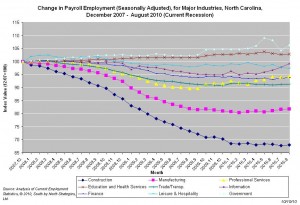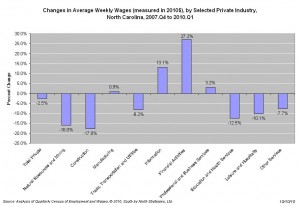Is Structural Unemployment NC’s Problem?
Last week, the WUNC radio program The State of Things devoted an entire episode to a discussion of North Carolina’s labor market. In the show’s second half, several speakers and callers claimed that the high level of joblessness affecting the state stems from a lack of workers qualified to hold available jobs.
The only problem with this reasonable-sounding argument is the lack of evidence to support it.
Labor economists argue that there are two broad kinds of unemployment: structural and cyclical. Think of structural unemployment as a supply shortage: jobs exist, but workers are not available to fill them, perhaps because they lack the requisite skills or perhaps because they live in the wrong place. Cyclical employment, in contrast, may be thought of as a demand shortage: workers are available but employers are not hiring. (Note that a third kind of unemployment, frictional unemployment, which results from voluntary job changes, also exists.)
Both structural and cyclical factors drive unemployment at different points in time. And over the long term, significant structural changes have occurred within North Carolina’s economy. Federal trade policies, for instance, have facilitated the off-shoring of textile production previously done in the Tar Heel state. Similarly, a decline in traditional industries located in rural areas has occurred alongside the growth of newer industries located in metropolitan areas.
Despite those long-term structural changes, the downturn that started in December 2007 is very much a cyclical one. Put differently, employer demand for labor has collapsed due to drops in demand for goods and services. Three pieces of data support this claim.
 First, if structural factors were at work, employment in some sectors would be declining while employment in other sectors would be rising due to the shift in demand. This is not currently the case in North Carolina. As the graph (right) shows, payroll employment has fallen in every major industry except for government and education and health services (an industry closely tied to government spending) since December 2007. Yet even in those two industries, the employment increases have been modest, up 6.2 percent and 2.9 percent respectively.
First, if structural factors were at work, employment in some sectors would be declining while employment in other sectors would be rising due to the shift in demand. This is not currently the case in North Carolina. As the graph (right) shows, payroll employment has fallen in every major industry except for government and education and health services (an industry closely tied to government spending) since December 2007. Yet even in those two industries, the employment increases have been modest, up 6.2 percent and 2.9 percent respectively.
Second, if structural factors were at work, wages in the growing sectors should rise as employers in those sectors compete to attract scarce workers. This is not currently the case in North Carolina. After adjusting for inflation, average weekly wages stayed flat or declined in seven of 10 private industries between 2007.IV and 2010.I (graph, below). Increases occurred only in the information (+13.1 percent), financial activities (+27.2 percent), and professional services (+3.2 percent) industries. And in the industries where average weekly wages rose, total payroll employment levels fell over the same period, suggesting that the wage increases went to compensate incumbent employees rather than attract new ones.
 Lastly, if structural factors were at work, the consequences would be reflected in the ratio of unemployed workers to job openings. Some sectors of the economy would have more unemployed workers than jobs, while other sectors would have more jobs than unemployed workers.
Lastly, if structural factors were at work, the consequences would be reflected in the ratio of unemployed workers to job openings. Some sectors of the economy would have more unemployed workers than jobs, while other sectors would have more jobs than unemployed workers.
In August 2010, however, there were far more unemployed workers than job openings in most every major industry. Although state specific data are unavailable, there were an estimated 4.3 unemployed workers per job opening in the South in August. While this ratio is lower than the national one, it is nevertheless high and points to weak demand for labor on the part of employers.
While the debate about structural and cyclical unemployment seems academic, it matters greatly to public policy. If structural employment is the problem, the role of public policy is limited to encouraging individuals to pursue additional education and supporting workforce development activities. In short, unemployment is an individual problem that requires an individual solution. If cyclical employment is the problem, however, public policy should play an active role in stimulating demand for goods and services. After all, rational firms only hire when there exists a market for the goods and services that the added labor would produce.
Nothing in the preceding discussion should be taken to mean that structural unemployment does not exist, that it has not touched segments of the state’s economy in the recent past, or that it might not be a problem in the future. In relation to the downturn that started in late 2007, however, the evidence for structural change is weak, and cyclical unemployment appears to be the greater problem — a problem that can be ameliorated by public policies focused on demand-side factors.
Moreover, a failure to address cyclical unemployment increases the odds that cyclical unemployment will curdle into structural unemployment. The longer that people are jobless, the less likely they are to return to work. This is because long spells of unemployment frequently are accompanied by a deterioration of skills, a loss of personal confidence, and a diminished ability to compete with other workers whom employers view not to be “damaged goods.”
Recent evidence suggests that dynamic now is unfolding in North Carolina. Since May some 77,500 North Carolinians simply have abandoned the labor force. Unless cyclical demand recovers soon, many of those individuals are apt to become unemployable and will be unlikely to return to work even when conditions improve. At that point, they will have crossed over to the ranks of the structurally unemployed. Not only is this harmful to individuals, but it also serves as a drag on future growth, thereby increasing the chances that more people will be knocked down.
The first step needed to avid this outcome is to recognize just what is troubling North Carolina’s labor market — a lack of demand — and act accordingly.


 Email Sign-Up
Email Sign-Up RSS Feed
RSS Feed